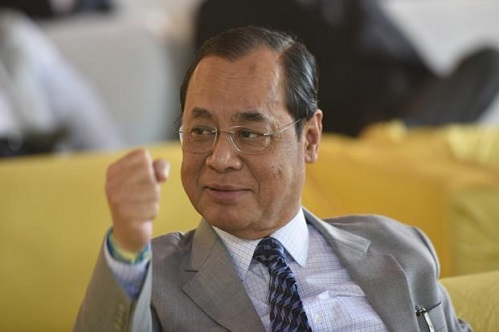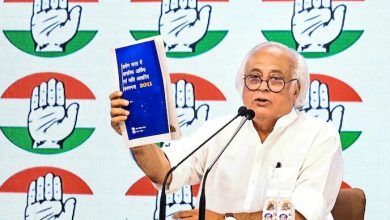
New Delhi: Justice Ranjan Gogoi, the first person from northeast to reach the top of judiciary and credited for bringing the curtains down on the decades-old politically and religiously sensitive Ayodhya land dispute, retired as the chief justice of India on Sunday.
Justice Ranjan Gogoi’s tenure as judge and as Chief Justice of India (CJI) was marked by some controversies and personal allegations but that never came in the way of his judicial work that was reflected in the last few days when benches headed by him delivered some path-breaking judgements.
He etched his name in the annals of history when a five-judge bench headed by him on November 9 brought an end to the Ayodhya land dispute, which dates back to even before the Supreme Court came into existence in 1950.
However, his tenure in the Supreme Court will also be remembered for being part of a presser by the ‘gang of four’ senior-most judges in January last year which questioned the then CJI’s way of functioning.
Later at a public function, Justice Ranjan Gogoi had remarked that “independent judges and noisy journalists are democracy’s first line of defence”.
A “revolution, not reform” was needed to keep the institution of judiciary serviceable for the common man, Justice Ranjan Gogoi had said at the same function.
Justice Ranjan Gogoi’s tenure as CJI was not free of controversy as he faced allegations of sexual harassment, of which he was cleared.
However, Justice Ranjan Gogoi is more likely to be remembered for the Ayodhya verdict that gave Hindus the 2.77 acre disputed land for construction of Ram Temple, and order that Muslims be given a 5-acre land at a “prominent location” to build a mosque in the city.
Justice Ranjan Gogoi also headed a bench which, by a majority 3:2 verdict, referred to a larger 7-judge bench the pleas seeking review of the Supreme Court’s historic 2018 judgement allowing women and girls of all ages to enter Kerala’s Sabarimala temple.
The majority verdict included in the ambit of the review petitions raising issues of alleged religious discrimination against Muslim and Parsi women as well.
Justice Ranjan Gogoi’s name will also be remembered for heading a bench which gave clean chit to the Modi government twice — first on the writ petition and then on Thursday on the pleas seeking review of the December 14, 2018 verdict — in the Rafale fighter jet deal with French firm Dassault Aviation.
The bench warned Congress leader Rahul Gandhi for wrongly attributing certain remarks to the Supreme Court in the Rafale case and asked him to be more careful in the future.
Besides, Justice Ranjan Gogoi headed a bench which, in a landmark verdict, held that the office of the CJI is a public authority under the Right to Information Act, but “judicial independence has to be kept in mind” while disclosing information in “public interest”.
On the same day, a 5-judge Constitution bench headed by him struck down in entirety the rules formulated by the Centre on appointment and service conditions for members of various tribunals, and referred to a larger bench the issue of examining the validity of the passage of the Finance Act 2017 as Money Bill.
These important decisions apart, Justice Ranjan Gogoi, known for his no-nonsense approach, boldness and fearlessness, also led a bench which monitored and ensured that NRC exercise in Assam, his native state, is completed within the set timeframe.
A lot of controversies plagued the National Register of Citizens (NRC) but he stood his ground and came out in public recently to defend the decision to hold the exercise to identify illegal immigrants.
Friday was the last day for his judicial work and he sat in the Supreme Court’s number one court for just about four minutes during which the lawyers’ body of the Supreme Court expressed gratitude to him.
He reached out through video conferencing to country’s judges in all high Courts and judicial officers of district and taluka courts on Friday.
The outgoing CJI in a signed statement later in the day expressed his inability to have one-to-one interview with journalists but lauded the press for its “maturity” and “character” in preventing “canards and falsehood” in “trying times” of the judiciary.
Justice Ranjan Gogoi, who was sworn on October 3, 2018 as the 46th CJI, had the tenure of a little over 13 months.
Since taking up the leadership of the Indian judiciary, and also as the judge of the Supreme Court before that, Justice Ranjan Gogoi faced several ups and downs but that did not affect his approach to take on issues head on.
While Justice Ranjan Gogoi was known for taking hard and sometimes surprising decisions, the Ayodhya matter reflected both as he ensured that arguments were not allowed to be dragged and wrapped up the hearing two days ahead of the scheduled deadline of October 18, saying ‘enough is enough’.
As the CJI, he took tough decisions against erring judges and recommended their transfers and a woman high court judge was virtually forced to resign. He also headed a bench which dealt with contempt proceedings against former Supreme Court judge Markandey Katju for his remarks against judiciary in his blog.





